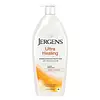What's inside
What's inside
 Key Ingredients
Key Ingredients

 Benefits
Benefits

 Concerns
Concerns

 Ingredients Side-by-side
Ingredients Side-by-side

Water
Skin ConditioningGlycerin
HumectantCetearyl Alcohol
EmollientPetrolatum
EmollientStearic Acid
CleansingC12-15 Alkyl Benzoate
AntimicrobialAluminum Starch Octenylsuccinate
AbsorbentDimethicone
EmollientLaureth-3
EmulsifyingCeteareth-20
CleansingAllantoin
Skin ConditioningArginine
MaskingSodium Hydroxide
BufferingCarbomer
Emulsion StabilisingParfum
MaskingPanthenol
Skin ConditioningLecithin
EmollientPentylene Glycol
Skin ConditioningAlcohol
AntimicrobialAscorbyl Palmitate
AntioxidantTocopherol
AntioxidantMethylparaben
PreservativePhenoxyethanol
PreservativeEthylparaben
PreservativeWater, Glycerin, Cetearyl Alcohol, Petrolatum, Stearic Acid, C12-15 Alkyl Benzoate, Aluminum Starch Octenylsuccinate, Dimethicone, Laureth-3, Ceteareth-20, Allantoin, Arginine, Sodium Hydroxide, Carbomer, Parfum, Panthenol, Lecithin, Pentylene Glycol, Alcohol, Ascorbyl Palmitate, Tocopherol, Methylparaben, Phenoxyethanol, Ethylparaben
Titanium Dioxide 5.8%
Cosmetic ColorantZinc Oxide 12.5%
Cosmetic ColorantWater
Skin ConditioningCaprylic/Capric Triglyceride
MaskingGlycerin
HumectantEthylhexyl Methoxycrylene
Skin ConditioningDimethicone
EmollientTriacontanyl Pvp
HumectantGlyceryl Stearate
EmollientCalcium Sodium Borosilicate
PEG-100 Stearate
Polyhydroxystearic Acid
EmulsifyingVp/Hexadecene Copolymer
Avena Sativa Kernel Extract
AbrasiveChrysanthemum Parthenium Flower/Leaf/Stem Juice
AntioxidantTocopheryl Acetate
AntioxidantXanthan Gum
EmulsifyingCetearyl Olivate
Sorbitan Olivate
EmulsifyingStearic Acid
CleansingTriethoxycaprylylsilane
Ethylhexylglycerin
Skin ConditioningSodium Chloride
MaskingPhenoxyethanol
PreservativeCetearyl Alcohol
EmollientChlorphenesin
AntimicrobialDisodium EDTA
Aluminum Hydroxide
EmollientIron Oxides
Titanium Dioxide 5.8%, Zinc Oxide 12.5%, Water, Caprylic/Capric Triglyceride, Glycerin, Ethylhexyl Methoxycrylene, Dimethicone, Triacontanyl Pvp, Glyceryl Stearate, Calcium Sodium Borosilicate, PEG-100 Stearate, Polyhydroxystearic Acid, Vp/Hexadecene Copolymer, Avena Sativa Kernel Extract, Chrysanthemum Parthenium Flower/Leaf/Stem Juice, Tocopheryl Acetate, Xanthan Gum, Cetearyl Olivate, Sorbitan Olivate, Stearic Acid, Triethoxycaprylylsilane, Ethylhexylglycerin, Sodium Chloride, Phenoxyethanol, Cetearyl Alcohol, Chlorphenesin, Disodium EDTA, Aluminum Hydroxide, Iron Oxides
 Reviews
Reviews

Ingredients Explained
These ingredients are found in both products.
Ingredients higher up in an ingredient list are typically present in a larger amount.
Cetearyl alcohol is a mixture of two fatty alcohols: cetyl alcohol and stearyl alcohol. It is mainly used as an emulsifier. Emulsifiers help prevent the separation of oils and products. Due to its composition, it can also be used to thicken a product or help create foam.
Cetearyl alcohol is an emollient. Emollients help soothe and hydrate the skin by trapping moisture.
Studies show Cetearyl alcohol is non-toxic and non-irritating. The FDA allows products labeled "alcohol-free" to have fatty alcohols.
This ingredient is usually derived from plant oils such as palm, vegetable, or coconut oils. There is debate on whether this ingredient will cause acne.
Due to the fatty acid base, this ingredient may not be Malassezia folliculitis safe.
Learn more about Cetearyl AlcoholDimethicone is a type of synthetic silicone created from natural materials such as quartz.
What it does:
Dimethicone comes in different viscosities:
Depending on the viscosity, dimethicone has different properties.
Ingredients lists don't always show which type is used, so we recommend reaching out to the brand if you have questions about the viscosity.
This ingredient is unlikely to cause irritation because it does not get absorbed into skin. However, people with silicone allergies should be careful about using this ingredient.
Note: Dimethicone may contribute to pilling. This is because it is not oil or water soluble, so pilling may occur when layered with products. When mixed with heavy oils in a formula, the outcome is also quite greasy.
Learn more about DimethiconeGlycerin is already naturally found in your skin. It helps moisturize and protect your skin.
A study from 2016 found glycerin to be more effective as a humectant than AHAs and hyaluronic acid.
As a humectant, it helps the skin stay hydrated by pulling moisture to your skin. The low molecular weight of glycerin allows it to pull moisture into the deeper layers of your skin.
Hydrated skin improves your skin barrier; Your skin barrier helps protect against irritants and bacteria.
Glycerin has also been found to have antimicrobial and antiviral properties. Due to these properties, glycerin is often used in wound and burn treatments.
In cosmetics, glycerin is usually derived from plants such as soybean or palm. However, it can also be sourced from animals, such as tallow or animal fat.
This ingredient is organic, colorless, odorless, and non-toxic.
Glycerin is the name for this ingredient in American English. British English uses Glycerol/Glycerine.
Learn more about GlycerinPhenoxyethanol is a preservative that has germicide, antimicrobial, and aromatic properties. Studies show that phenoxyethanol can prevent microbial growth. By itself, it has a scent that is similar to that of a rose.
It's often used in formulations along with Caprylyl Glycol to preserve the shelf life of products.
Stearic Acid is a fatty acid. It is an emollient, emulsifier, and texture enhancer.
As an emollient, stearic acid helps soften skin. It aids the skin's protective barrier by preventing water loss. It also provides a gentle cleansing effect without stripping away natural oils.
Stearic acid may also be used to enhance the texture of products. It can add volume and stabilize ingredients such as water and oil. This can help water and oil ingredients from separating.
Sources of stearic acid include animal or vegetable fats/oils such as coconut or shea. It can be naturally found in butter, cocoa butter, shea butter, vegetable fats, and animal tallow.
This ingredient may not be Malassezia folliculitis, or fungal-acne safe.
Learn more about Stearic AcidWater. It's the most common cosmetic ingredient of all. You'll usually see it at the top of ingredient lists, meaning that it makes up the largest part of the product.
So why is it so popular? Water most often acts as a solvent - this means that it helps dissolve other ingredients into the formulation.
You'll also recognize water as that liquid we all need to stay alive. If you see this, drink a glass of water. Stay hydrated!
Learn more about Water